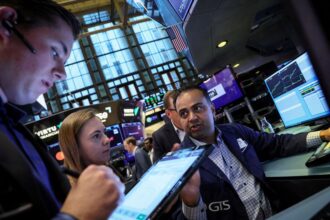A handful of big themes are set to take hold in the new year, two of which are the likelihood that the U.S. will lead a drop in inflation across major developed markets that also produces a turn in interest rates.
That’s the view of Neil Shearing, group chief economist at Capital Economics in London, who also expects economic growth to be weaker than expected for most countries in 2024. Soft growth, falling inflation, and lower interest rates should be accompanied by a bond market that rallies, he wrote in a note on Monday.
Read: Bonds are flashing a ‘smile’ after historically bad stretch, a promising sign for 2024
Traders returned from the Thanksgiving holiday and abbreviated Friday session to find markets continuing to cling to the view that a soft landing, or scenario of falling inflation with no recession or big upturn in unemployment, is about to come true. Two-
BX:TMUBMUSD02Y,
10-
BX:TMUBMUSD10Y
and 30-year Treasury yields
BX:TMUBMUSD30Y
posted their biggest one-day declines in almost two weeks amid broad-based buying of government debt. Meanwhile, U.S. stocks finished lower with the Dow Jones Industrial Average
DJIA
and S&P 500
SPX
pulling away from Friday’s closing levels, which were the highest since August.
While the soft-landing view is held by big-name economists such as Jan Hatzius of Goldman Sachs Group Inc., one big caveat remains. The path of inflation still isn’t certain, with a Bloomberg survey showing that a number of economists expect underlying prices from the Fed’s favorite inflation measure to remain stubborn through 2024 and to keep interest rates higher. The next update for that measure, known as the PCE, is set to be released on Thursday.
See: Health of several key sectors, including the U.S. consumer, plus an outlook from Fed’s Powell on radar this coming week
“We think that U.S. inflation will ultimately slow more quickly than Fed officials expect,” Shearing wrote. “But inflation will also drop across the eurozone, the U.K. and other major DMs [developed markets]…2024 is likely to be the year where core inflation finally moves back toward central banks’ comfort zone of around 2%.”
His firm holds the view that the current post-Covid inflation scare is more analogous to the inflation shock which followed World War II than the surge of the 1970s. In other words, inflation is “still being driven heavily by pandemic-related supply distortions” and should continue to come down as those distortions fade, according to Shearing.
In turn, central banks across advanced economies “are likely to loosen policy,” with the Fed poised to lead the global easing cycle because the disinflationary process is further along in the U.S. and “there appears to be greater institutional hawkishness within the ECB [European Central Bank].”
In the U.S., fed-funds futures traders appeared to be backing up that view on Monday. They’re pricing in an 88% likelihood of one or more Fed rate cuts by next July, up slightly since Friday, according to the CME FedWatch Tool.
Other key themes that Shearing expects to unfold in 2024 are global economic growth that comes in below consensus forecasts for all major economies and regions; underperformance by the eurozone and U.K. relative to the U.S.; structural weakness in China; and building enthusiasm for artificial intelligence, which “has the potential to drive a significant increase in productivity growth.”
Finally, Capital Economics also expects elections across the world — from the U.S. and the U.K. to Indonesia and India — to drive the news cycle and become sources of possible short-term volatility for financial markets.
Read the full article here








